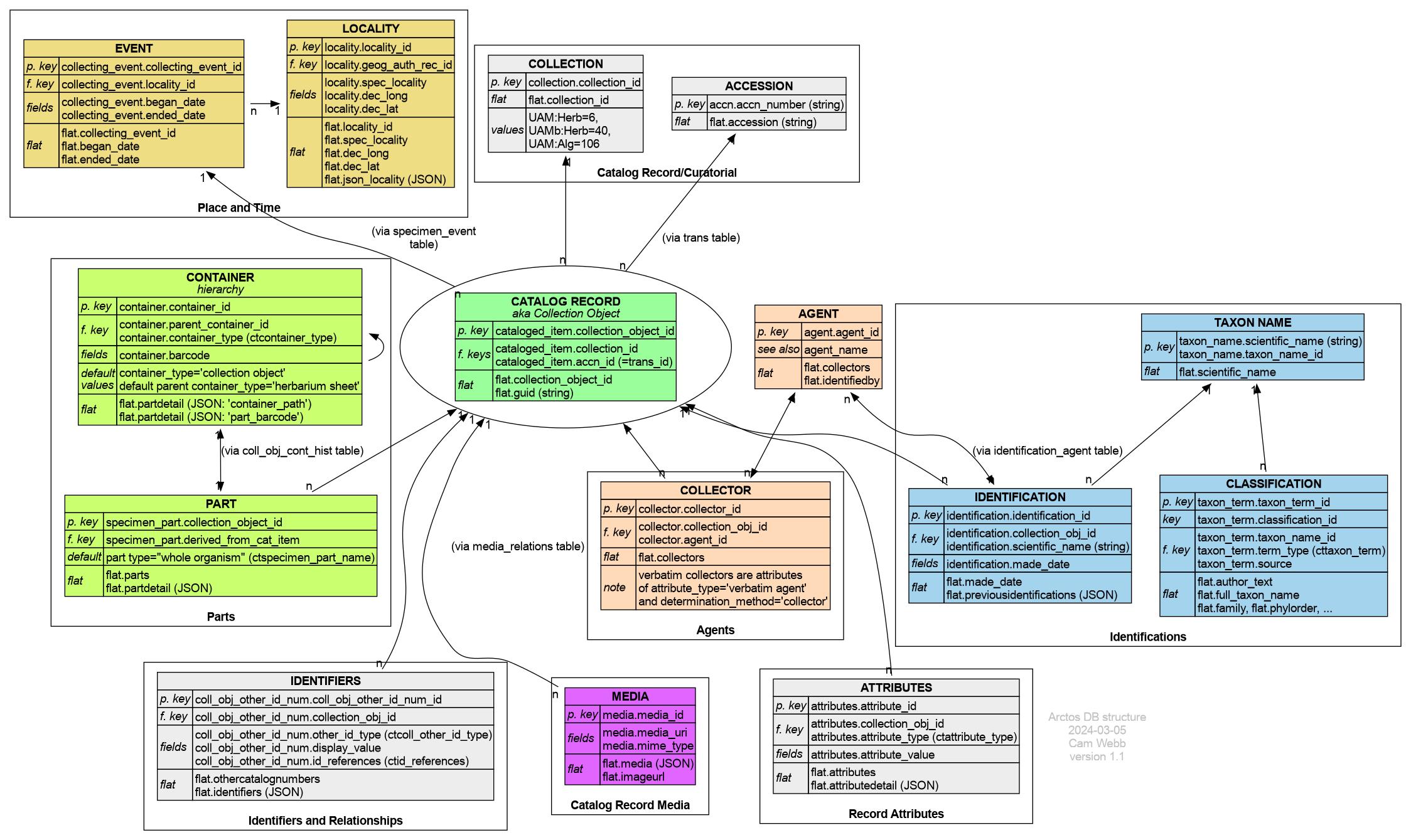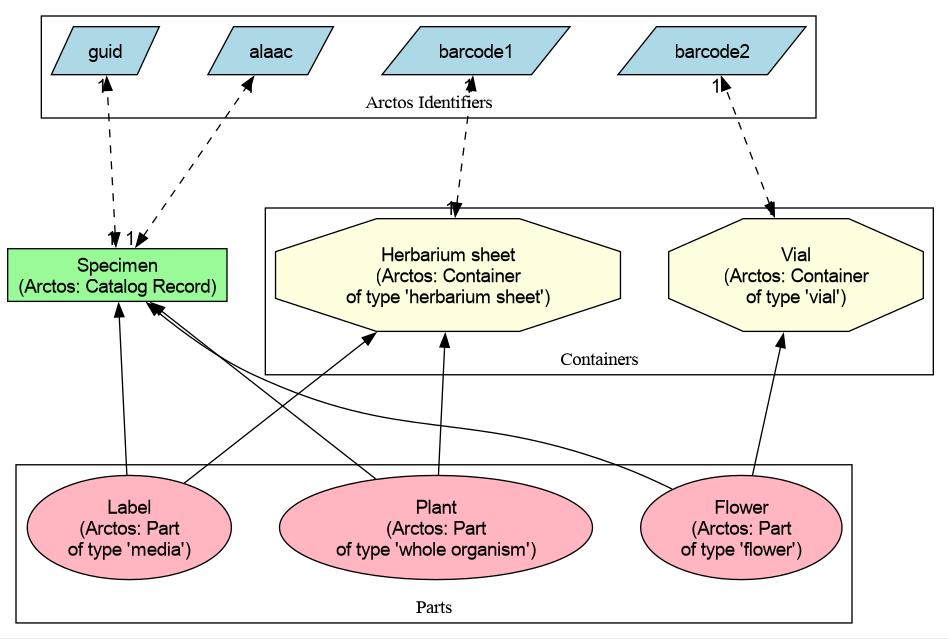The data model
The Arctos data model
This is an overview of the Arctos data model, with key tables, and how
some of the key data elements appear in the flat table. It is not a
full ER diagram, more a map of the territory. The diagram is also
available as a PDF with clickable links to the relevant table
documentation in Arctos.

Key:
- outline boxes: represent the panels within the Arctos catalog record page
- colored tables: primary tables in the Arctos DB
- p. key: primary key in the main, original data table
- f. key(s): foreign keys in the original data table
- fields: other primary fields in the original data table
- flat: the fields in
flatwhich represent data from the original table - Edges:
- n ➡ 1: multiple records of the first table relate to a single record in the target table
- n ↔ n: multiple records of the first table relate to multiple record in the target table
- 1 ↔ 1: a single record of the first table relates to a single record in the target table
The diagram was made with GraphViz. Source.
Mapping ALA physical objects to Arctos data model
(In the following, Arctos concepts are in bold type, physical
objects or concepts are in italic type, and identifiers are in
monospaced type)
- SPECIMENS
- The physical unit that is represented by the Arctos Catalog Record is the Specimen (aka Collection).
- Each specimen has a unique
ALAAC(ALA accession number), so there should be a one-to-one mapping of ArctosGUIDtoALAAC. Note: rarely, ALA stores duplicates of the same physical collection, which have the same collector number, the same ALAAC, and should be represented by the same Arctos record (i.e. same GUID); these duplicates will however have different barcodes.
- PARTS
- Each Specimen may contain one or more elements of several
kinds:
- a whole organism (common for herbs), or
- a part of an organism (leaf, twig, flower, e.g., from a tree), or
- a paper label.
- These physical elements are represented in Arctos as Parts.
- Each Part is of a type, controlled by the ctspecimen_part_name code table.
- At a minimum, every Arctos Record has one Part, of default type whole organism.
- In reality, there may be several whole organisms in a collection (common for small, alpine plants). These may be modeled as separate Parts in Arctos if it is useful, but usually are represented as a single Part of type whole organism.
- Cases where it is useful to indicate separate elements as
additional Parts (see this specimen for a full set of
elements)
- A part of an organism, e.g., a leaf (Part type: leaf) has been sent for destructive sequencing,
- A part of an organism, e.g., a flower (Part type: flower) exists in an alcohol collection.
- A DNA sample exists separate from the specimen, in a local or external lab (Part type: DNA).
- A physically large plant is cut up and pasted to several herbarium sheets (Part types: whole organism and/or leaf)
- An exact duplicate of a collection (i.e., all data the same, but two or more physical sheets).
- There is an annotation label on the herbarium sheet, other than a ‘det slip’ (which are recorded in Arctos as additional Identifications). This is represented as a Part of type media.
- Each Specimen may contain one or more elements of several
kinds:
- CONTAINERS
- Physically, all elements of a collection exist somewhere, usually attached to a single herbarium sheet.
- Arctos models this by allowing each Part to be contained in a Container. Usually a whole organism occurs in/on a Container of type herbarium sheet.
- Each Container may have a
barcode, but Parts do no themselves have barcodes. - Different Parts of one Catalog record may exist in different Containers
- NOTE: In rare cases, a single Container may contain Parts
from different Records. For example, rarely two
individuals of different species were attached to the same herbarium
sheet (and so cannot be called a single specimen). They should be
assigned to different Records with different
GUIDandALAAC, even though the collector and event info is the same. Each of the Records will have Parts that share the same herbarium sheet Container (andbarcode) with the other Record. - Containers themselves can be housed hierarchically in other Containers which each have barcodes and descriptions. This permits herbarium sheets to be found: cabinet > shelf > folder > sheet.
- To enter data for a large specimen than has been split up and
attached to several herbarium sheets, a single Catalog
Record with a single
ALAACshould have several Parts, with each of these Parts housed in a different Container of type herbarium sheet, each with a differentbarcode. - A wet collection of a flower should be a separate Part of a Record, with type flower, and contained in a Container of type vial.

Identifiers
Using the above model, the following should be true:
- Each
GUIDshould have a singleALAAC(note: unique ALAACs are not enforced by Arctos) - Rarely, each
GUIDandALAACmay have one or morebarcodes - Rarely, a single
barcodemay be associated with more than oneGUIDandALAAC
Anny cases of multiple ALAAC for a single GUID should be investigated and duplicate records deleted. Because cases (2) and (3) above are rare, they should be checked manually.